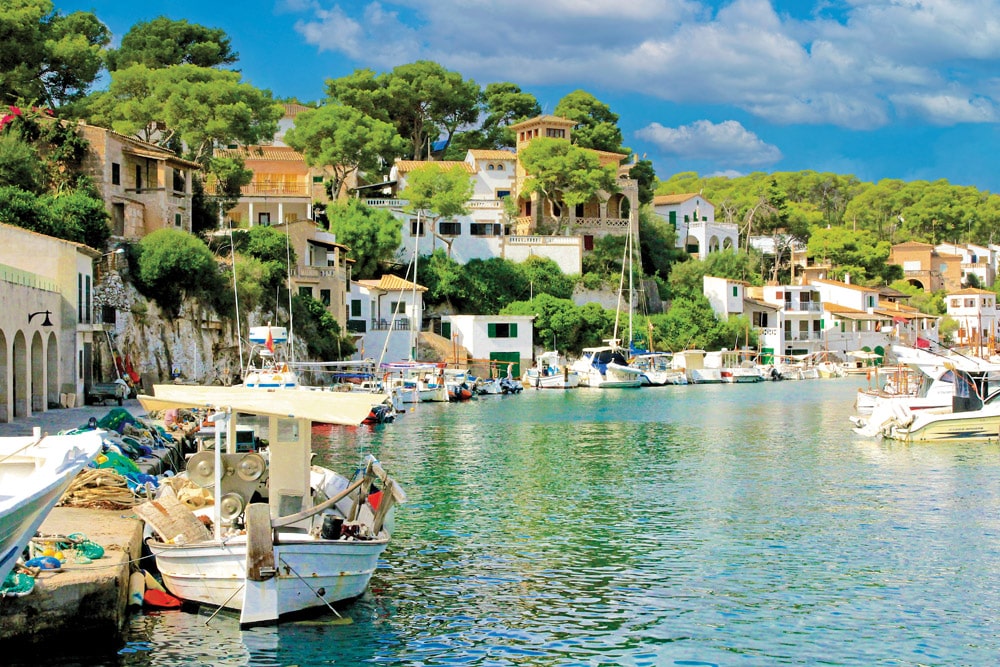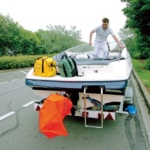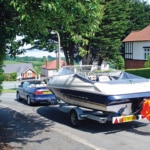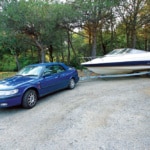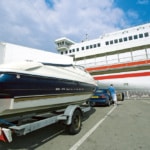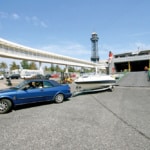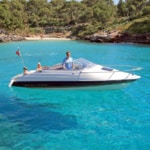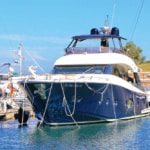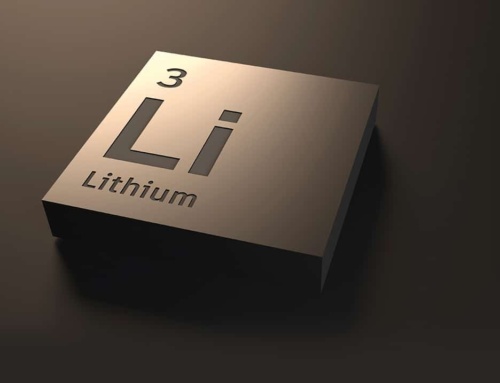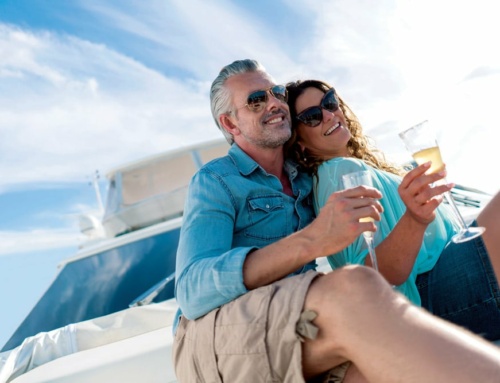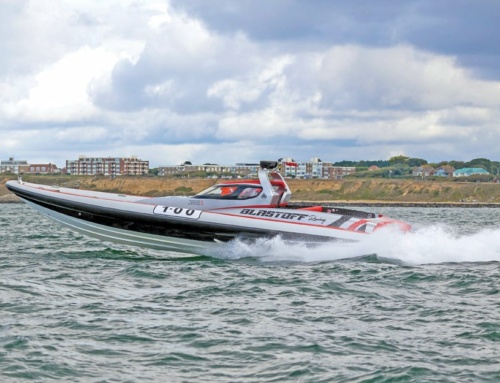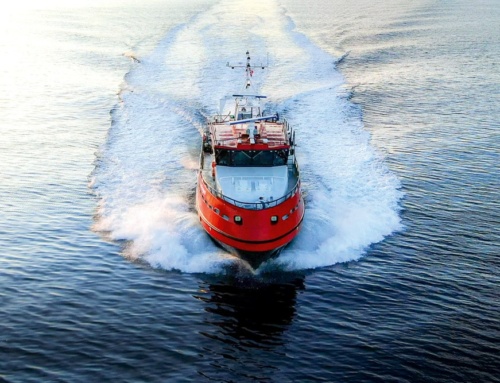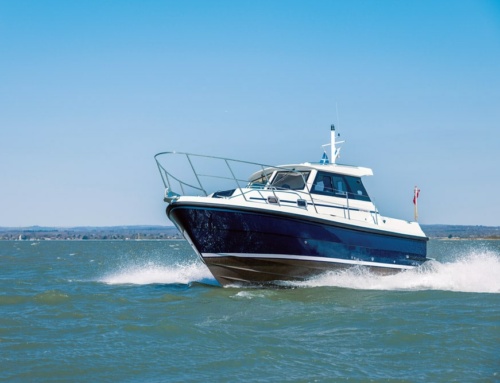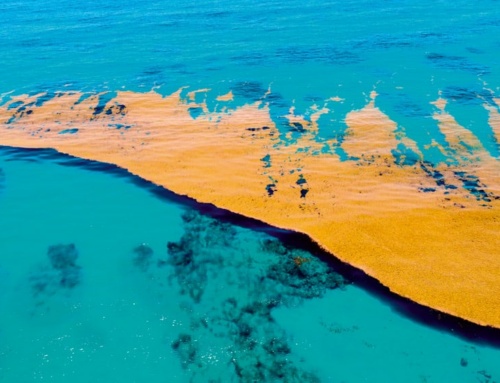The notion of towing your boat to a Mediterranean island may seem a contradiction in terms, but where there’s a will, there’s a way, as PBR’s sports boating adventurer Alex Whittaker recounts.
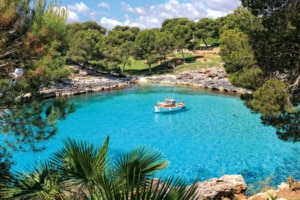
Cala Mitjana is small but perfectly formed.
The idea came to me in the winter – one wet Wednesday night, in fact. Here was the deal: instead of towing our boat to Scotland or the Lakes for the summer holidays, why not tow her overland to Mallorca? We had towed our previous boat to the French Med, south of Perpignan, so what about towing our new boat just a half a day further over the Spanish border to Barcelona? From there we could then take the ferry to Palma de Mallorca. I was self-employed, and we had just made the last payment on our mortgage. I could easily reshuffle my working year to fit in a long trip. After only a few more red wines, it seemed like a great idea.
Mallorca dreaming
I spoke to my wife, who absolutely loved the idea of sunbathing for six weeks. I then spoke to my grown-up son. Would he like to share the driving with me? Alex T. immediately replied in the affirmative; however, he and his girlfriend had work commitments. They could only manage a two-week holiday. Alex said he would tow the boat out with me before getting a cheap flight home. He would then return for the last two weeks to help me tow the boat back. Both our female crew liked the idea of skipping the long, hot road trip and said they would fly out to join us.
Six weeks
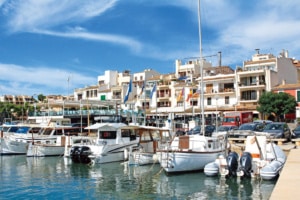
Porto Petro, a couple of sea miles from Cala d’Or.
So we were on – six weeks in the Med! Now, before you faint at the cost, trust me: this can work out cheaper than you might expect. To achieve this, you must ruthlessly control your foreign accommodation costs, and after that, you effectively transfer your UK day-to-day living costs to the Med. Mrs Whittaker and I decided to install ourselves in an inexpensive three-star hotel. Cannily, we put our son and his girlfriend in a cheap and cheerful hostel. Because we wanted so many bed nights and could pay cash, we could negotiate a good price locally, which saved us quite a bit of money over the six weeks. In addition, while we were negotiating, our three-star hotel had a booking glitch, but they transferred us to an equally good hotel closer to the marina, chopped off a few quid and threw in free half-board to sweeten the deal.
Trip prep
We were using our ancient Saab convertible to tow our 21ft Bayliner 2052 Cuddy. I began by getting the car and trailer serviced, and I bought a number of ‘on the road’ items. After all, a 2,700-mile trip needs preparation.
- Alex T. checking the trailer in northern France
- Setting off from home in Wales.
- Leaving an overnight autoroute stopover.
Documentation
I began my planning by making up a plastic A4 folder to keep all of the passports, ship’s papers, ferry tickets, roadside assistance data and insurance documents in one place (see boxout 1). I also loaded all the key details, such as roadside breakdown telephone numbers and bank helplines, directly onto my mobile phone. In addition, I took quick but legible phone photos of all the key paper documents and bought a small backpack into which I put my documentation folder. I added all our other portable goodies, phones, cameras, etc. for those times when we left the car and trailer to go walkabout. I deliberately bought a cheap, bright nylon beach-shop backpack, avoiding anything that looked expensive. When we left the car and trailer to eat, or sort out the ferry, I was always carrying the important things with me on my back, hands-free. My son and I shared exactly half our stash of cash elsewhere at all times. On such road trips, we habitually take duplicate credit cards, plus spare car and boat keys (on floating fobs), just in case. These are the kind of fussy but valuable little jobs you attend to once, and they abide for each trip.
Two drivers
Having an adult son to share the driving was marvellous. Two drivers allow you to make much better progress, and I reckon it is much safer. The trip via Dover, Calais and across northern France went swimmingly. Using the autoroute all the way meant tolls but better progress. Although we were towing with my old Saab ragtop, for the really hot days crossing southern France and northern Spain, we found it was much more comfortable to drive with the windows closed, hood up and the air con on full blast. Because we had two drivers we could continue driving into the cool of the evening. Thus we covered more ground in a day. Swerving hotel costs, Alex T. and I slept on the boat in French motorway aires. Overnight, we always parked in the lights, by the café. We ate at the Autoroute Du Soleil cafés, always with the boat clearly in sight. Mrs Whittaker had packed the boat cabin out with all the heavy stuff that she did not want to take on a jet. This clobber included suitcases, shoes, handbags, cosmetics, hair dryers, boots, sun lotions, coats, ready-ironed ball gowns and the like. On the road, Alex and I were relegated to sleeping in the cockpit on the Bayliner’s sunbeds.
Road pirates
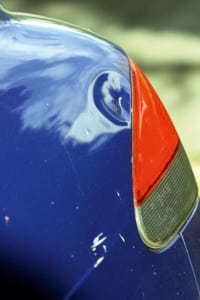
Our venerable Saab ragtop battered by road pirates!
We were making good progress and had already crossed the Pyrenees by the end of day two – the trusty old Saab cabrio treated the mountains with contempt. On the other side, we dropped the car hood down for the last few miles for our triumphal entry into Barcelona. Or so we thought. It was at this point that events went decidedly pear-shaped. Things happened so fast too. My son was driving and I just happened to be looking in the door mirror. I noticed a man in a late-model Mercedes drawing up to us in the next lane. Suddenly he threw something from his car. At that moment, there was a loud bang at the back of the Saab. The bossy Scandinavian dashboard lit up like a slot machine. A buzzer sounded and a telltale symbol indicated a brake light fault. Instantly I was pumped full of adrenaline. However, my son, like the hardened trailer boater he is, drove on and just checked the trailer and its tyres in his mirrors. There were no significant issues and the rig felt good. I told Alex what I had seen. The man in the Mercedes had thrown a rock at our car, which had damaged our rear light. The Merc man and his passenger pulled alongside and angrily motioned at me to wind down my window. He shouted that our trailer had hit his car. Utter rubbish, of course. When we did not comply, he waved a handgun. We were being hijacked. Now my son was very alert. I can’t print what he shouted at the occupants of the Merc, but suffice to say that Alex T. was very annoyed. The Merc swerved dangerously ahead of us and slowed down, trying to force us to pull over. It stopped halfway over the dusty hard shoulder, with one door open, in an attempt to block us further. Our mood instantly switched to blind blazing anger. All this kerfuffle at 60mph when towing a trailer was a bit too much. These jokers were going to try to rob us on a busy Spanish motorway in broad daylight. Alex T. decided to plough on.
I shouted: ‘Take his door off if you have to, Al. Alex waved his fist. The Merc man, when he realised we were serious, looked horrified and quickly leapt out of the way. We missed the Mercedes’ open door by inches. The strange thing is that we were now both very angry as hell, but hugely indignant at the same time. It was a message the would-be hijackers seemed to get. The Merc caught us up, the occupants shouted a bit, and then they sped off. We trundled on and remained alert.
It was lucky we did, for within the hour, another scam team tackled us, this time in a late-model Audi. They had the same modus operandi: throw a rock and frighten the soft Johnnie English into pulling over. This time the rock bounced harmlessly off the trailer, but by then we were fighting mad. I waved a mole grip at them – it was all I had. They soon sped off. Not long before our docks turn-off, which seemed to take an age, unbelievably a third team took us on. This time they were in an old Peugeot and brandished a child’s gold plastic police badge. I reckon that the road pirate must have understood my angry Anglo-Saxon reply. We drove on.
Ferry time
We stopped to tell the police manning the dock gates, but frankly, we got no response. We arrived at the ferry early, but of course, the ferry company would not let us load until the next day. I had decided to use the fast catamaran service – a bit dear, but only a four-hour crossing. Since the ferry staff would not let us park at the terminal, we had to weigh up our options. Fed up with Barcelonian hospitality, or the lack of it, we took a calculated risk. We decided that going back near the French border for the night would be safer. We spent the night safely at the motorway halt. We then travelled into Barcelona just after dawn next morning when all the Spanish gangsters were asleep. On the autopsista we tucked up safely between two handy Spanish lorries for most of the way.
- Waiting for the fast cat at Barcelona.
- Arriving at Palma de Mallorca docks.
We finally got aboard the fast cat. This was interesting, since the loading deck is very restricted for a car and trailer. The Spanish loading staff were superb, but since our round trip cost a cool 800 euros, I had expected free champagne at least. Bang on four hours later, after a fast but bumpy crossing, we landed at Palma de Mallorca. We had just relaxed, and turned up a busy road, when we heard a rear tyre burst. The Mallorca police were immediately at hand. You could tell they were proper policemen. They were courteous, very laid-back and most helpful. They told us we were free to park on the wide pavement to let the buses pass, and Alex T. set about changing the wheel. A nice lady came out of her rather swish apartment. I must have looked shattered as she offered us coffee and cake, even though we were blocking her garage door. Soon we were back on the road. It was a balmy night with the hood down, towing by moonlight. We reached the marina and our favourite Smugglers Bar well after midnight. The staff remembered us from our marina scouting expedition the year before. Alex and I sat drinking Soberano into the wee small hours, trying to fathom out our mad day on the road.
Marina days
The Cala d’Or Marina staff were hugely efficient. Next morning, they hoisted our little Bayliner into the water. They were astounded we had trailered so far overland to their marina. We were actually in the Med, gassed up and ready to go. The marina also issued us a perfect berth, right on the front of the marina, next to the shops and a very posh restaurant. At this point I fulfilled a long-held dream – I tied my own boat to a palm tree on a Mediterranean island!
Neighbours
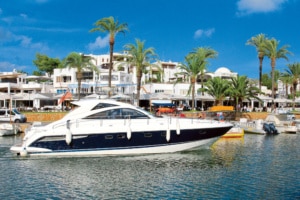
Cala d’Or, looking towards the chandlery.
The berth for our little 21-footer was amusingly placed – right next to a multimillion-pound, multi-decked yacht. The owner had his meals delivered from the restaurant three times a day. It was like a movie. The three waiters arrived in a small procession, wearing starched white ‘bum freezers’, holding their amazing grub aloft on silver chargers. The elderly owner was a very nice man, and over the next few weeks he would engage me in light conversation from the gods two decks above. Directly across the marina we could see Michael Schumacher’s yacht, complete with matching Ferrari, reputedly being looked after by his dad. I reflected that my 10-grand, 10-year-old little Bayliner was floating in the same water as these jet-set gin palaces.
Night flight
At midnight I drove the Saab to the airport to pick up Mrs Whittaker. Since her luggage from the boat cabin had already been installed at the hotel by her dutiful son, she sauntered out of the arrival hall with no bags at all – carrying only an unfinished split of Moët.
Cruising base
We had chosen our cruising base at Cala d’Or with care. It is a very scenic location, only an hour or so from the fast cat terminal at Palma de Mallorca. The marina has petrol, and for smaller boats such as ours, it offered a less costly berth at the quay. This was much cheaper than a fully serviced pontoon berth. The marina is situated on a coast full of impressive calas (coves). In fact, there are over a dozen calas to explore within a half-day cruise. Cala d’Or is also an attractive holiday town. Significantly for us, it offers accommodation and restaurants with prices to suit most pockets.
- Mallorquino friends told us about their tuna contests.
- Volare suspended in the clear waters of Cala Mitjana.
- Rafa Nadal’s boat was moored in Porto Cristo.
Nez à quai
The first Med boating technique you need to master is tying up the nose of your boat to the quay. Luckily the low quay at our berth required only a short step down onto our boat’s foredeck. The marina quay had a ring, and there was already one rope tied off to it. This rope ran at 90 degrees to the quay, disappearing underwater to a very heavy chain on the bottom. Our technique was to idle up to the quay nose first and pick up the marina’s submerged line with our boat hook. It is better to wear gloves since the muddy line will have barnacles and tiny shellfish that will cut you. This wet line was then temporarily looped around the rear cleat, while I sprang up onto the top deck and made fast our bow line to the ring on the quay. Then it is simply a matter of ‘tuning’ the tension on the two ropes to hold the boat safely off, but within easy stepping distance of the quay. You have to board and leave the boat by the front deck, and this means tugging the boat’s front line to pull the boat onto the quay. It quickly becomes second nature. However, it can be a bit of a juggle carrying a cooler box full of food, drinks and ice.
Cala Mitjana
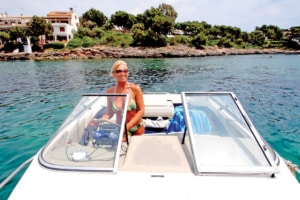
Mrs Whittaker sunbathing at Cala d’Or, then on to Porto Petro.
Alex T. had to return home, so Mrs Whittaker and I decided to make a first cruise to nearby (and truly breathtaking) Cala Mitjana. It was a stunning morning with a cloudless blue sky, hot as the Bahamas and no wind at all. Cala Mitjana is only a few sea miles from the marina. Our Bayliner had barely clocked up a smart 35 knots when we spotted the seamark at the entrance to the cala. We dropped off the plane, burning off speed as we carved a white path straight into the entrance. Mitjana is a famous dog-leg cala, so any swell or chop at sea does not penetrate too deep inside. It is ringed by cinder toffee cliffs, palm trees and exotic plants lining its rocky rim. It’s more Maui than Mallorca. The sea is so clear that our boat looked suspended in amethyst. There is even a tiny beach at the head of the cala. We noticed rusty iron spikes driven into the stone cliffs almost at water level. These allow larger boats to anchor with a second line ashore. We anchored near the head of the cala over pristine white sand. It proved easier to work the anchor safely from the cockpit in our small boat with no windlass. As usual, I streamed a couple of floating stern lines to two bright foam ‘pool noodles’, making a small bathing area. Mind you, the swim into the beach is only about 100 metres. The snorkelling here over the sand and rocks is superb, even with the 10-euro snorkel set I’d bought from the supermarket that morning. Long striped fish, like black and white silk ties, were everywhere. I pulled myself hand over hand down the anchor line to stand on the bottom and look for more fish. Above me, Mrs Whittaker sat on the bathing platform reading one of her Inspector Montalbano books, with her feet in the water. It was the end of May, so we were the only boat in the cala.
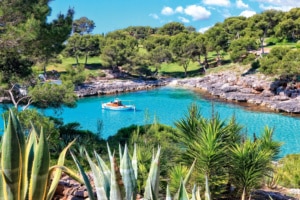
Exotic Cala Mitjana.
Now, it so happens that there is a stunning residence right on this cala. It looks like a Bond villain’s lair. There were uniformed servants driving electric golf carts over neatly manicured paths. We realised that the carts were shuffling elegant family members down to the private gazebo on the beach for luncheon. It was utterly fascinating to observe from the aft deck of our own modest Bayliner. However, seeing these beautiful people eating their starters made us hungry. Mrs Whittaker and I ate longitudinally sectioned fresh baguettes, filled with local cheese, ham, peppers and olives. I was on the fizzy mineral water, but Mrs W. sipped some chilled cava from one of our gracious plastic flutes. Dark Side of the Moon was on the boat stereo as we sunbathed. All in all, an idyllic day.
Lifestyle
The days rolled on into weeks, and we were no longer on holiday. We were mallorquinos for the season. There was no rush and no compulsion. We just took each subtropical day as it came. On windy days we stayed and pottered round inside the three calas that make up Cala d’Or. In this way we did not have to tackle the big waves beyond the harbour and could always find shelter to anchor for swimming. We discovered a local market and we were soon eating local fruit and vegetables, drinking local wine and having cold melon for dessert. This made sense because everything was cheaper than at the supermarket.
Wind cycles
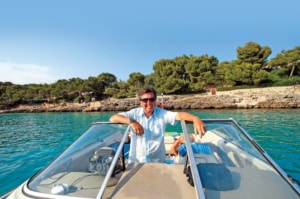
Our daily routine followed the cycle of the winds. We went out for a fast blast early in the morning and anchored in a sheltered cove for an early lunch, followed by sunbathing, snorkelling and reading. Then we raced home before the afternoon winds cut up rough. Sometimes we took a sunset cruise. These choices meant we were mostly fast cruising over smooth seas in warm sunlight. We became as brown as berries and got into the habit of taking an afternoon siesta. Soon we were going out to dinner in inexpensive small family restaurants recommended to us by the hotel staff. We had set a notional weekly eating out budget but found that we never exceeded it. We were lucky enough to get to know some superb local people, who gave us great advice about calas, tuna fishing and where to go on public feast days. I also met a marvellous German lad who ran the local chandlery. The Bayliner’s bilge pump suddenly stopped working, so I had to buy another, and my new German pal pointed out that it was an American cassette pump. I could just buy the cassette and not a whole new pump. This meant that I did not have to struggle to unscrew the old one from under the V6. These fine people were in addition to those legends we met among the thriving ex-patriate boating community.
The vibe
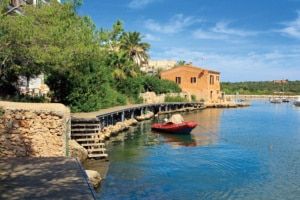
The boardwalk on the way to Porto Petro. Note too the typical stern first fore and aft med-styled mooring.
Alex T. and his girlfriend flew out to join us. Then my brother and his wife made the trip. This changing and overlapping of family crews was a delight in itself. We tended to go cala hunting every other day, sunbathing locally at anchor in the gaps. After six weeks, the mallorquino lifestyle was seeping into our souls. The real discovery was that if you stayed on the island for over a month, your heart rate slowed right down. The rhythm of the boating days was soothing. It became normal to be out on your boat seven days a week, for weeks on end. It never got stale. Most significantly, you really got to know your boat and, every so often, how she behaved in less-than-ideal conditions. On the windy days when I got it wrong and had to punch back through big seas, I knew she would always bring us home safely. I learned that my baby Bayliner could make a fast dash, two up, with 40 knots on the GPS, and that she could also sip petrol at displacement speeds when fuel was low. As an all-round party platform for six weeks, she proved she was superb.
Car and trailer
-
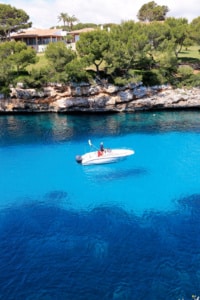
Mallorca really does have some idyllic spots.
Gallon of fresh water
- Car, boat and trailer fuses
- Toolkit and WD-40
- Gaffer tape for blown hoses
- Spare bulbs for car & trailer
- Extending torque wrench for obstinate wheel nuts
- Spare boat & car fan belts
- Fluorescent prop bag plus bungees to secure it
- Ratchet strops to hold the boat fast to the trailer
- A trailer wheel clamp
- A tow hitch security device
- Spare trailer bearing kits
- Hot knife to cut rope
- Two torches, one on the boat, one in the car
- Battery charger for marina use
- Extra-long jump lead set (boat and car use)
- Foot pumps: 12V DC and foot to blow up soggy car and trailer tyres
- Two Finilec emergency auto tyre puncture inflator aerosols
- Trolley jack
- Spare wheel for trailer
- Cooler box
Bayliner 2052 LC Cuddy
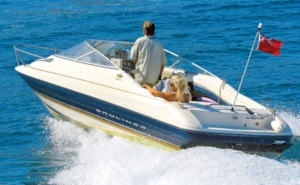 Our second-hand Bayliner, Volare, was 10 years old when we made the trip. She is a 21-footer with a 220hp MerCruiser V6 petrol engine and Alpha One outdrive, has three fold-down sunbeds and can seat six. She is a fast and manoeuvrable sports boat.
Our second-hand Bayliner, Volare, was 10 years old when we made the trip. She is a 21-footer with a 220hp MerCruiser V6 petrol engine and Alpha One outdrive, has three fold-down sunbeds and can seat six. She is a fast and manoeuvrable sports boat.
Road pirates
If you are attacked:
- Do not stop.
- Keep your cool, they are trying to disorientate you.
- Do not act as a victim, show them you have rumbled their scam.
- Video them with your phone to put them off.
- Carry on until you see a police car, can pull off at a police post or reach your destination.
- Note also that some travellers have been gassed unconscious and robbed in their motorhomes as they slept at overnight halts on the Spanish autopista.
Documentation
- Your name on your passport and your driving licence name should match.
- UK driving licence, photo version preferred, and it must be in date for your whole trip.
- Vehicle continental breakdown cover insurance, including the trailer, from the AA/RAC, etc.
- Travel insurance for everyone making the trip.
- Car V5 registration document.
- Green card insurance document is no longer needed for France or Spain.
- Small Ships Register documentation for your boat (from RYA). Though not mandatory, it is often helpful at foreign marinas.
- International Certificate of Competence (ICC) for all boat drivers (from RYA). My son and I also took RYA courses for Powerboat Level II (Coastal).
- UK sticker for car (not GB) now required. GB sticker now no longer valid.
- Spare bulbs for car required in France and Spain.
- Beam deflectors for UK car headlamps.
- Boat insurance documents covering trailer too.
- Boat’s bill of sale to prove its VAT paid status.
- Proof of vaccination (UK COVID pass or EU equivalent) – easy to get online. Note masks may still be required in some countries.
- Spain requires one long or two short reflectors on the back of any trailer exceeding 12 metres.
- At least six months must be left on your passport, and the passport must not be more than 10 years old.
- VHF licence.

